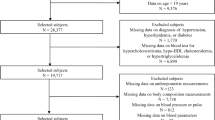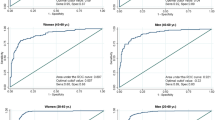Abstract
OBJECTIVE: To use factor analysis to examine the putative role of leptin in the Metabolic Syndrome, and to define better the associations among observed variables and the identified factors.
DESIGN: Factor analysis of cross-sectional data from a 1987 survey.
SUBJECTS: Non-diabetic residents of Mauritius who participated in population-based surveys in 1987 and 1992 (1414 men and 1654 women).
MEASUREMENTS: Fasting and 2 h plasma glucose and insulin following a 75 g oral glucose load; seated blood pressure; body mass index (BMI); waist-to-hip ratio (WHR); and fasting serum triglycerides, HDL-cholesterol, leptin and uric acid concentrations.
RESULTS: Principal components factor analysis revealed three factors for men and women that explained between 54 and 55% of the observed variance of the 12 measured variables. General features of these factors were as follows: factor 1, WHR, BMI, leptin, fasting and 2 h insulin, triglycerides, and HDL-cholesterol; factor 2, systolic and diastolic blood pressure, uric acid (men only), and fasting glucose (women only); and factor 3, fasting and 2 h glucose and insulin. Only three variables loaded on more than one factor with a loading ≥0.4 (fasting and 2 h insulin, fasting glucose in women only). Leptin loaded on one factor only in both men and women.
CONCLUSIONS: Since multiple factors underlie the Metabolic Syndrome, and since no observed variable loads on all three factors, more than one mechanism might account for the observed clustering of risk characteristics. Leptin does not unite features of this syndrome due to its loading on one factor only. Uric acid is related to a different factor in men and women. The absence of gender differences in factor loadings argues for similar mechanisms for the Metabolic Syndrome in men and women in Mauritius.
This is a preview of subscription content, access via your institution
Access options
Subscribe to this journal
Receive 12 print issues and online access
$259.00 per year
only $21.58 per issue
Buy this article
- Purchase on Springer Link
- Instant access to full article PDF
Prices may be subject to local taxes which are calculated during checkout
Similar content being viewed by others
References
Zimmet P . The pathogenesis and prevention of diabetes in adults. Genes, autoimmunity, and demography Diabetes Care 1995 18: 1050–1064.
Zimmet P . Hyperinsulinaemia—how innocent a bystander Diabetes Care 1993 16: 56–70.
Zimmet P, Collins V, de Courten M, Hodge AM, Collier GR, Dowse GK, Alberti KG, Tuomilehto J, Hemraj F, Gareeboo H, Chitsou P, Fareed D . Is there a relationship between leptin and insulin sensitivity independent of obesity? A population-based study in the Indian Ocean nation of Mauritius Int J Obes Relat Metab Disord 1998 22: 171–177.
de Courten M, Zimmet P, Hodge A et al. Hyperleptinaemia: the missing link in the Metabolic Syndrome? Diabetic Med 1997 14: 200–208.
Pelleymounter M, Cullen M, Baker M, Hecht R, Winters D, Boone T, Collins F . Effects of the obese gene product on body weight regulation in ob/ob mice Science 1995 269: 540–543.
Schwartz M, Baskin D, Bukowski T, Kuijper JL, Foster D, Lasser G, Prunkard DE, Port D, Woods SC, Seeley RJ, Weigle DS . Specificity of leptin action on elevated blood glucose levels and hypothalamic neuropeptide Y gene expression in ob/ob mice Diabetes 1996 45: 531–535.
Kieffer T, Heller R, Leech C, Holz G, Habener J . Leptin suppression of insulin secretion by activation of ATP-sensitive K+ channels in pancreatic β-cells Diabetes 1997 46: 1087–1093.
Emilsson V, Liu Y-L, Cawthorne M, Morton N, Davenport M . Expression of the functional leptin receptor mRNA in pancreatic islets and direct inhibitory action of leptin on insulin secretion Diabetes 1997 46: 313–316.
Koyama K, Chen G, Wang M-Y, Lee Y Shimbukuro M, Newgard CB, Unger CH . β-cell function in normal rats made chronically hyperleptinemic by adenovirus-leptin gene therapy Diabetes 1997 46: 1276–1280.
Cohen B, Novick D, Rubenstein M . Modulation of insulin activities by leptin Science 1996 274: 1185–1188.
Taylor S, Accili D, Imai Y . Perspectives in diabetes. Insulin resistance or insulin deficiency: which is the primary cause of NIDDM? Diabetes 1994 43: 735–740.
Stevens J . Applied Multivariate Statistics for the Social Sciences. Lawrence Erlbaum: Mahwah, NJ 1996.
Leyva F, Godsland I, Ghatei M, Prowdler AJ, Aldis S, Walton C, Bloom S, Stevenson LG . Hyperleptinaemia as a component of a metabolic syndrome of cardiovascular risk Arterioscler Thromb Vasc Biol 1998 18: 928–933.
Dowse G, Gareeboo H, Zimmet P, Alberti KG, Tuomilehto J, Fareed D, Brissonnette LG, Finch CF . High prevalence of NIDDM and impaired glucose tolerance in Indian, Creole and Chinese Mauritians Diabetes 1990 39: 390–396.
Dowse G, Zimmet P, Gareeboo H, Alberti GK, Tuomilehto J, Finch CF, Chitson P, Tulsidas H . Abdominal obesity and physical inactivity as risk factors for NIDDM and impaired glucose tolerance in Indian, Creole and Chinese Mauritians Diabetes Care 1991 14: 271–282.
WHO, World Health Organization . Diabetes mellitus report of a WHO Study Group. WHO: Geneva 1985.
Meigs J, D'Agostino R Sr, Wilson P, Cupples L, Nathan D, Singer D . Risk variable clustering in the Insulin Resistance Syndrome. The Framingham Offspring Study Diabetes 1997 46: 1594–1600.
Edwards K, Austin M, Newman B, Mayer E, Kruass R, Selby J . Multivariate analysis of the insulin resistance syndrome in women Arterioscler Thromb 1994 14: 1940–1945.
Stern M . The insulin resistance syndrome. In: Alberti K, Zimmet P, DeFronzo R, Keen H (eds) International Textbook of Diabetes Mellitus, Vol 1: Wiley: Chichester 1997 pp 255–283.
Soeldner J, Slone D . Critical variables in radioimmunoassay of serum insulin using the double antibody technique Diabetes 1965 14: 771–779.
Dowse G, Zimmet P, Alberti K, Brigham L, Carlin JB, Tuomilehto J, Knight LT, Gareeboo H . Serum insulin distributions and reproducibility of the relationship between 2-hour insulin and plasma glucose levels in Asian Indian, Creole and Chinese Mauritians Metabolism 1993 42: 1232–1241.
Muoio D, Dohn G, Fiedorek F Jr, Tapscott E, Coleman R . Leptin directly alters lipid partitioning in skeletal muscle Diabetes 1997 46: 1360–1363.
Pan D, Lillioja S, Kriketos A, Milner MR, Baur LA, Bogardus C, Jenkins AB, Storlien LH . Skeletal muscle triglyceride levels are inversely related to insulin action Diabetes 1997 46: 983–989.
Couillard C, Lamarche B, Mauriège P, Cantin B, Dagenais GR, Moorjani S, Lupien PJ, Despres JP . Leptinemia is not a risk factor for ischaemic heart disease in men. Prospective results from the Quebec Cardiovascular Study Diabetes Care 1998 21: 782–786.
McNeely MJ, Boyko EJ, Weigle DS, Shofer JB, Chessler SD, Leonnetti DL, Fujimoto WY . Association between baseline plasma leptin levels and subsequent development of diabetes in Japanese Americans Diabetes Care 1999 22: 65–70.
Donahue RP, Bean JA, Donahue RD, Goldberg RB, Prineas RJ . Does insulin resistance unite the separate components of the insulin resistance syndrome? Evidence from the Miami Community Health Study Arterioscler Thromb Vasc Biol 1997 17: 2413–2417.
Cigolini M, Targher G, Tonoli M, Manara F, Muggeo M, De Sandre G . Hyperuricaemia: relationships to body fat distribution and other components of the insulin resistance syndrome in 38-year-old healthy men and women Int J Obes Relat Metab Disord 1995 19: 92–96.
Schmidt M, Duncan B, Watson R, Sharrett A, Brancati F, Heiss G . A metabolic syndrome in whites and African-Americans Diabetes Care 1996 19: 414–418.
Reaven GM . The kidney: an unwilling accomplice in Syndrome X Am J Kidney Dis 1997 30: 928–931.
Leyva F, Wingrove CS, Godsland IF, Stevenson JC . The glycolytic pathway to coronary heart disease: a hypothesis Metabolism 1998 47: 657–662.
Gray R, Fabsitz R, Cowan L, Lee E, Howard B, Savage P . Risk factors clustering in the insulin resistance syndrome. The Strong Heart Study Am J Epidemiol 1998 148: 869–878.
Dowse G, Collins V, Alberti K, Zimmet PZ, Tuomilehto J, Chitsou P, Gareeboo H . Insulin and blood pressure levels are not independently related in Mauritians of Asian Indian, Creole or Chinese origin J Hypertens 1993 11: 297–307.
Zimmet PZ, Collins VR, Dowse GK, Alberti KG, Tuomilehto J, Knight LT, Gareeboo H, Chitsou P, Fareed D . Is hyperinsulinaemia a central characteristic of a chronic cardiovascular risk factor syndrome? Mixed findings in Asian Indian, Creole and Chinese Mauritians Diabetic Med 1994 11: 388–396.
Laakso M . How good a marker is insulin level for insulin resistance? Am J Epidemiol 1993 137: 959–965.
Yajnik C, Naik S, Bhat D, Joshi VM, Shelgikar KM, Alberti KG, Hockaday TD . The relationship between obesity, plasma immunoreactive insulin concentration and blood pressure in newly diagnosed Indian Type 2 diabetic patients Diabetic Med 1993 10: 146–151.
Maggio C, Pi-Sunyer F . The prevention and treatment of obesity. Application to type 2 diabetes Diabetes Care 1997 20: 1744–1766.
Liese A, Mayer-Davis E, Tyroler H, Davis CE, Keil U, Duncan BB, Heiss G . Development of the Multiple Metabolic Syndrome in the ARIC cohort: joint contribution of insulin, BMI, and WHR Ann Epidemiol 1997 7: 407–416.
Acknowledgements
This study was partially funded by US National Institutes of Health grant DK-25446. The study was undertaken with support and collaboration of the Ministry of Health (Mauritius) and the World Health Organization (Geneva and Mauritius).
Author information
Authors and Affiliations
Corresponding author
Rights and permissions
About this article
Cite this article
Hodge, A., Boyko, E., de Courten, M. et al. Leptin and other components of the Metabolic Syndrome in Mauritius—a factor analysis. Int J Obes 25, 126–131 (2001). https://doi.org/10.1038/sj.ijo.0801522
Received:
Revised:
Accepted:
Published:
Issue Date:
DOI: https://doi.org/10.1038/sj.ijo.0801522
Keywords
This article is cited by
-
Effect of soy on metabolic syndrome and cardiovascular risk factors: a randomized controlled trial
European Journal of Nutrition (2018)
-
Prevalence of metabolic syndrome in a cohort of Chinese schoolchildren: comparison of two definitions and assessment of adipokines as components by factor analysis
BMC Public Health (2013)
-
Serum leptin is associated with cardiometabolic risk and predicts metabolic syndrome in Taiwanese adults
Cardiovascular Diabetology (2011)
-
Leptin cut-off values for determination of metabolic syndrome: third national surveillance of risk factors of non-communicable diseases in Iran (SuRFNCD-2007)
Endocrine (2011)
-
Clustering of metabolic syndrome components in a Middle Eastern diabetic and non-diabetic population
Diabetology & Metabolic Syndrome (2010)



